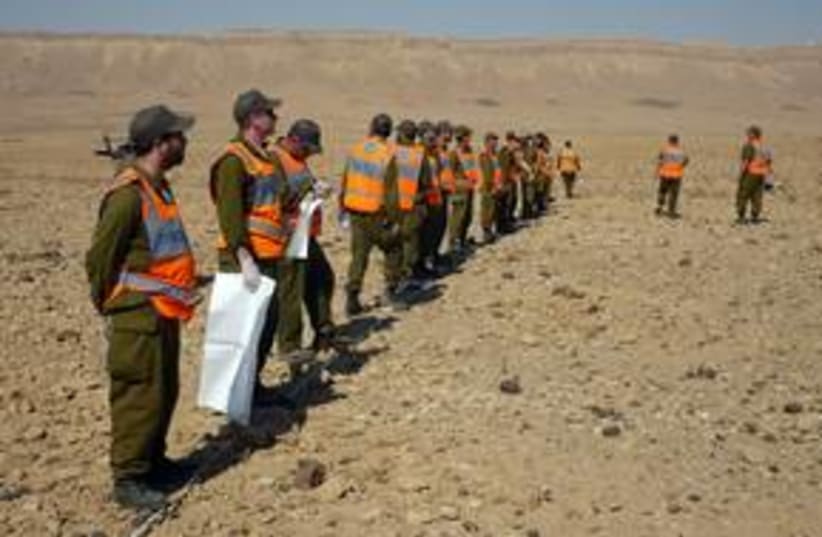A human error – possibly a miscalculation in altitude – was what caused an F-16I fighter jet to crash late Wednesday night in southern Israel killing two airmen, according to preliminary findings of an Israeli Air Force investigation.The remains of IAF pilot Maj. Amihai Itkis, 28, and navigator Maj. Emanuel Levi, 30, were found Thursday afternoon after almost 24 hours of searches throughout the Ramon Crater. IAF commander Maj.-Gen. Ido Nehushtan notified the pilot and navigator's families of the news.RELATED: Israel signs contract to buy F-35 stealth fighterStorks put IAF fighter jets on alert in Judean DesertIAF officers said that the F-16I – Israel’s newest and most-advanced fighter jet – would remain grounded until the air force could rule out that a mechanical malfunction caused the crash. One possibility under investigation is that the plane’s entire electrical system shut down, preventing the crew from issuing a distress call.Other possibilities under investigation are that a bird hit the plane and caused the crash or that the pilot simply miscalculated his altitude during the night flight. While the plane has systems to warn of low altitude, a pilot is able to set the altitude at which the alarm should go off. It is unclear, at this stage, at what altitude Itkis set the system. IDF Chief of General Staff Lt.-Gen. Gabi Ashkenazi said Thursday that an investigation into the incident had been opened immediately, and that everything possible would be done to prevent future accidents of the same kind.“Most urgent for us is to uncover the cause of the crash and find out if something hit the plane or if the crash was caused by human error or a mechanical malfunction,” a senior IAF officer said Thursday.During the day, search teams uncovered the plane’s black box which, if not overly damaged, might be able to provide insight into the cause of the crash and possibly enable investigators to reconstruct the dialogue between Itkis and Levi. “The crew did not issue a distress call,” the officer said. “It simply disappeared from the radar screen and other pilots saw a huge explosion on the ground below.”Itkis and Levi’s plane was at the head of a formation that was drilling dogfights with enemy aircraft. It was their third flight of the day and their second at night. The plane’s last maneuver was intercepting an “enemy” aircraft at around 11,000 feet, following which it lower its altitude until it suddenly hit the ground.Called the Sufa by the IAF, the F-16I is the IAF’s newest plane and alongside the F-15I, it’s most advanced. Fitted to Israel's specifications, these aircraft are different from any other F-16, even those in the service of the US Air Force.The Sufa was the first F-16 in the IAF armed with the AMRAAM air-to-air missile, giving it superior survivability and the ability to shoot down other jets up to 50 kilometers away. It also is equipped with a Northrop Grumman APG- 68 radar, which is generations more advanced than the radars now in service in the IAF fleet. The Synthetic Aperture Radar system and Litening navigation pod gives the F-16I all-weather, day and night attack capabilities.The plane has proven its air superiority in Israel’s recent conflicts during the Second Lebanon War in 2006 and Operation Cast Lead in the Gaza Strip in 2009 but has also encountered some problems since arriving in Israel.While Israel purchased 102 airplanes, one crashed during a landing in the 2006 Second Lebanon War due to a malfunction. Last September, another F-16I had to make an emergency landing after experiencing engine failure during a routine training flight.The pilot decided to shut down the engine and made an emergency landing at the nearby Ramon Air Force Base in the Negev. After that incident, Nehushtan grounded the planes so they could all be inspected.A year earlier, Nehushtan also grounded the plane after formaldehyde was found in the cockpit of one of the aircraft.The decision to suspend training flights was made after a number of pilots complained of a bad smell coming from the cockpit of one of the planes. The IDF Medical Branch conducted tests and discovered that the smell was caused by a type of formaldehyde known to be carcinogenic in high concentration.While air accidents are mostly down in the IAF, there have been a number of tragic crashes in recent years, most recently during a search-and-rescue exercise in Romania when an IAF Sikorsky CH-53 – known as the Yasour – crashed in the Carpathian Mountains, killing six IAF airmen and a Romanian military officer.Last month, Nehushtan decided to temporarily suspend a nationwide IAF exercise after a Black Hawk helicopter flew into an electrical cable in northern Israel. No one was injured. In July however, a female air force cadet was lightly injured after ejecting from the cockpit of her Efroni single-engine turboprop training aircraft during a landing.In September, 2009, Assaf Ramon, son of Israeli astronaut Ilan Ramon, was killed in a training accident. Ramon was flying an older model F-16 that exploded.In 2008, two pilots were killed when their Zukit training plane crashed in the Negev and another two veteran reserve pilots were killed when their Cobra attack helicopter crashed in the North.
JPost.com staff contributed to this report.
Miscalculation in altitude may have caused F-16I jet crash
Preliminary findings of IAF investigation point to human error; Ashkenazi says everything possible will be done to prevent future accidents.
